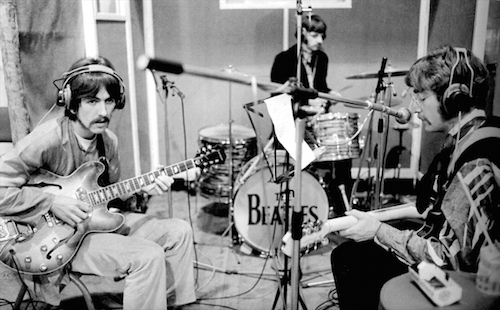Have you ever been in a position where you’ve got a great line of lyric for your verse or chorus, but you simply can’t come up with anything that follows it? It can be a great frustration.
In this video, you hear George Harrison trying to come up with a second line for his hit song “Something.” You can hear Lennon coming up with possible answering lines to “Something in the way she moves/ Attracts me like…” “… a cauliflower”; “…a screwdriver”. It’s pretty funny.
But when you’re stuck, it’s anything but funny. Here’s something to try when you simply can’t come up with a line:
- Record yourself singing the first line with a basic instrumental accompaniment.
- Continue recording, instrumental only, for however many beats you need to fill with the missing second line of lyric.
- Loop your recording.
Now it’s time to create that missing line of lyric. Play your recording on an endless loop and sing along with yourself. When you get to where the second line of lyric should be, make up anything.
And don’t worry too much about trying to come up with something “right.” In the case of recording that rehearsal for “Something”, Lennon says “Just say whatever comes into your head each time –“Attracts me like a cauliflower” — until you get the word.”
With each pass through that problem spot, you’ll be surprised how many words and lines you’ll create before you start to hear possible lines happening. It can sound pretty funny, and I think humour is a great way to lessen frustration and keep things in perspective.
Don’t be surprised or frustrated by how many times you go through the problem spot. Taking an entire week to solve this shouldn’t be seen as a wasted week. It can take a lot of time. You’ll discover also that you may be trying too hard to get something that rhymes, when an approximate rhyme (or no rhyme at all) is all that’s necessary.
This method will serve you well no matter what style of music you write. And it also works in a rehearsal scenario, where you can work these ideas out with your bandmates.
You can take that idea and modify it to fill in other missing song elements, like trying to figure out what chords should follow the ones you’ve already got, creating bits of missing melodies, and so on.
 Written by Gary Ewer. Follow Gary on Twitter
Written by Gary Ewer. Follow Gary on Twitter
Gary’s new ebook “Hooks and Riffs: How They Grab Attention, Make Songs Memorable, and Build Your Fan Base“ is continuing to be offered free with your purchase of “The Essential Secrets of Songwriting” eBook Bundle. Don’t miss this time-limited deal. Read more.











I like this method, but I also like writing different versions of the lyrics in notebooks until I hit on something good. In both cases, the important thing is to give yourself permission to say something silly or cliche or boring before you get to the real lyric.
Thanks for that advice, Raul… I like it!
-Gary
Pingback: First Beatle To Have a Solo Number One Hit - Thunderbird37
Excellent advice Gary, there is also another method I know you are
aware of, and it’s a method used by consistently good writers like Sting
and that is finding a great Hook/ Title and working back from that , sort
of doing things in reverse, The Beatles John and Paul nearly always
used this method Yes They also tended to write very short Chorus’s that
most would refer to as a Refrain Examples would be Ticket To Ride
Paperback Writer – From Me To You -I Want To Hold Your Hand –
Generally just repeating The Hook/ Title Of course both methods
are used but Neil Diamond tended to keep to short Chorus ‘s
Forever in Blue Jeans – Sweet Caroline – You Dong Bring Me Flowers-
Long wordy chorus’s are usually too much for today’s impatient
audiences – Something- by George Harrison did not really have a chorus
but it had clever composer modulations and Two Great Bridges
Thanks, Peter – Great comment!
-G
Where’s the video you reference?
Sorry. It didn’t come up in the email version of this article.